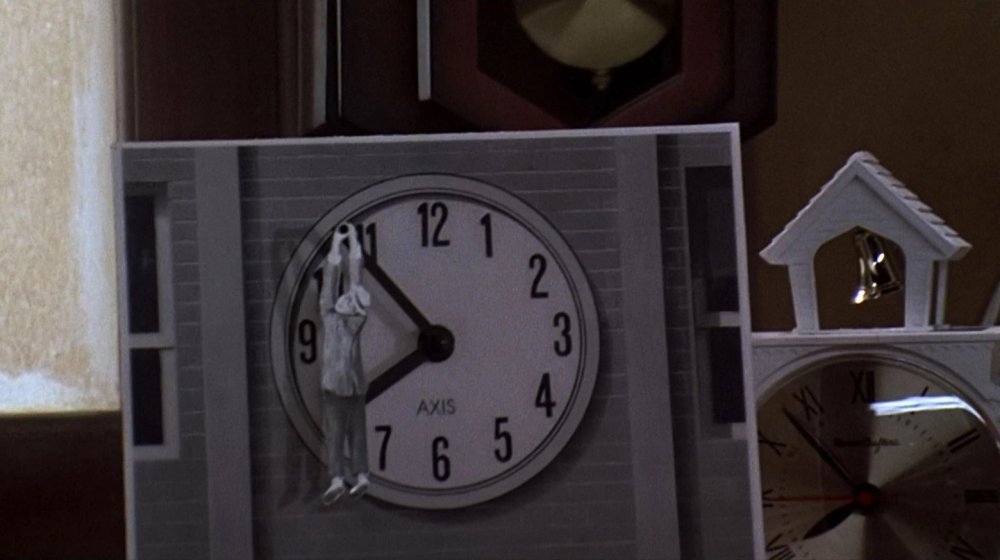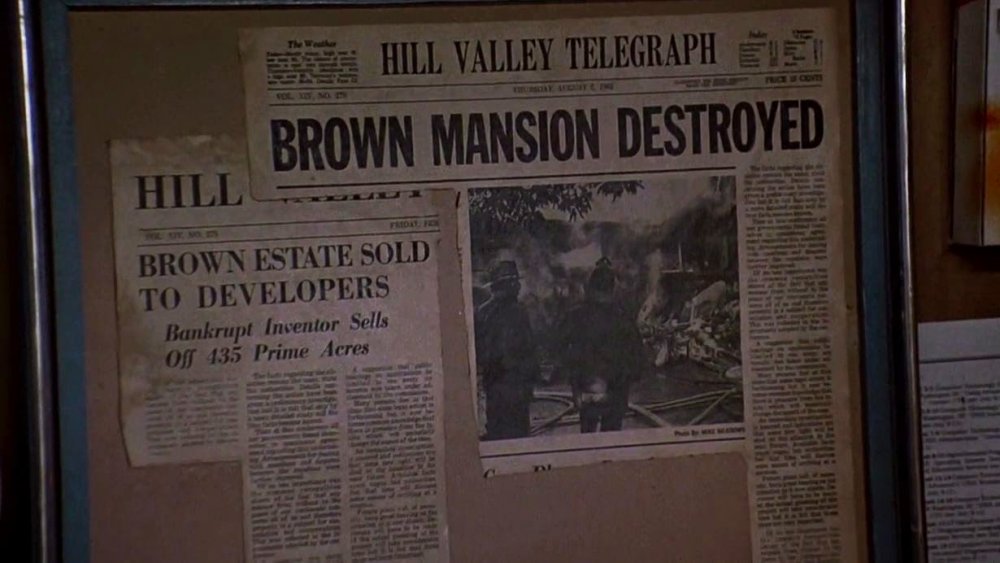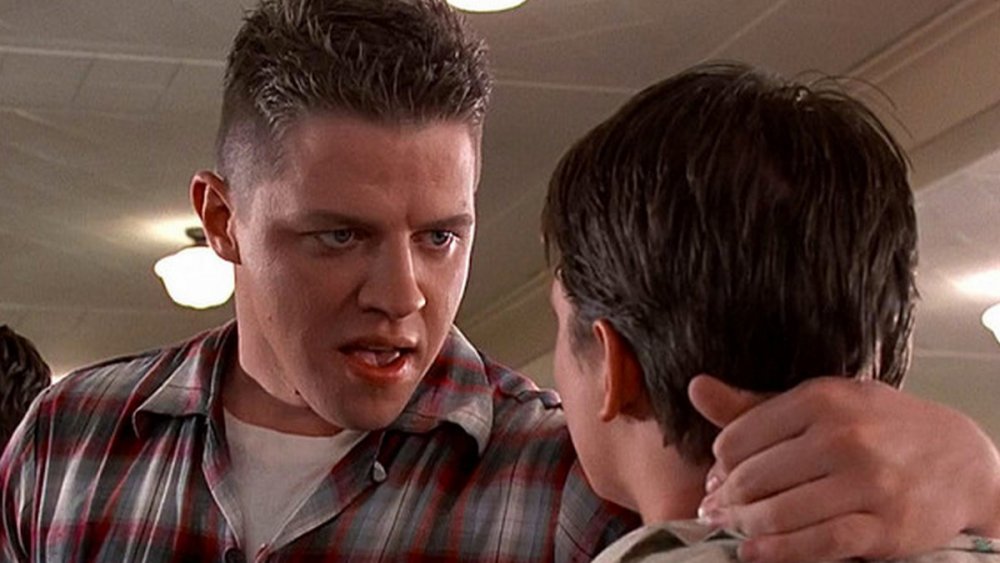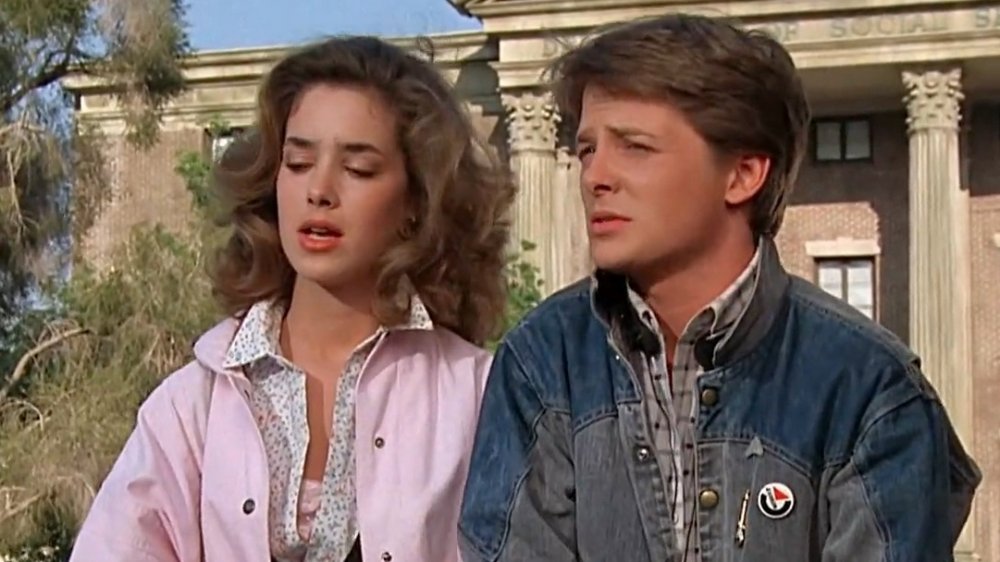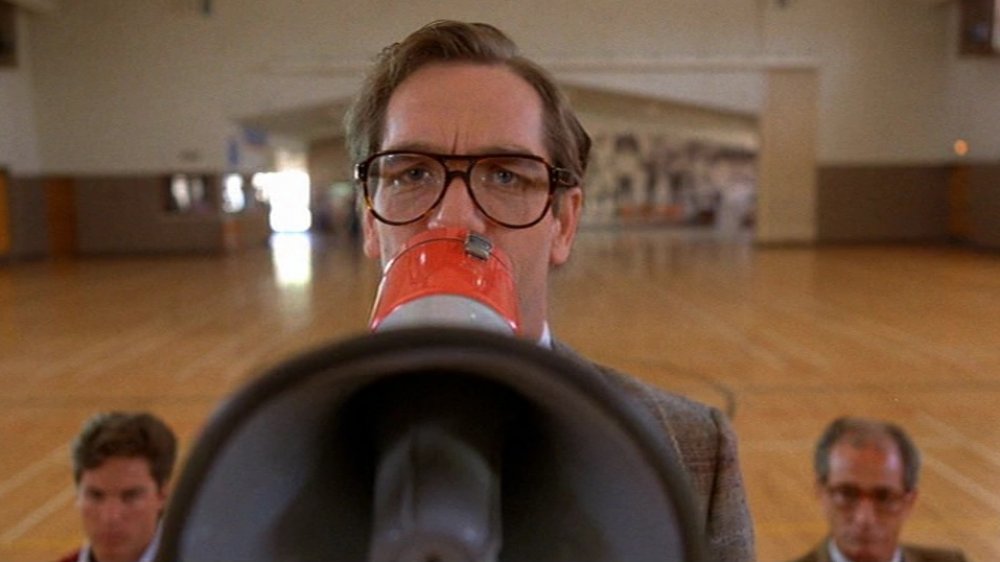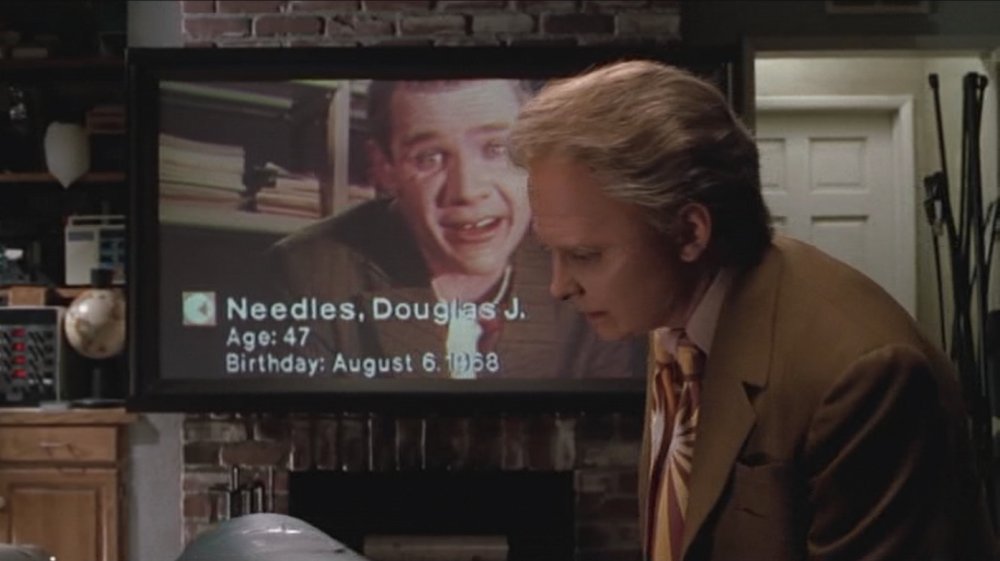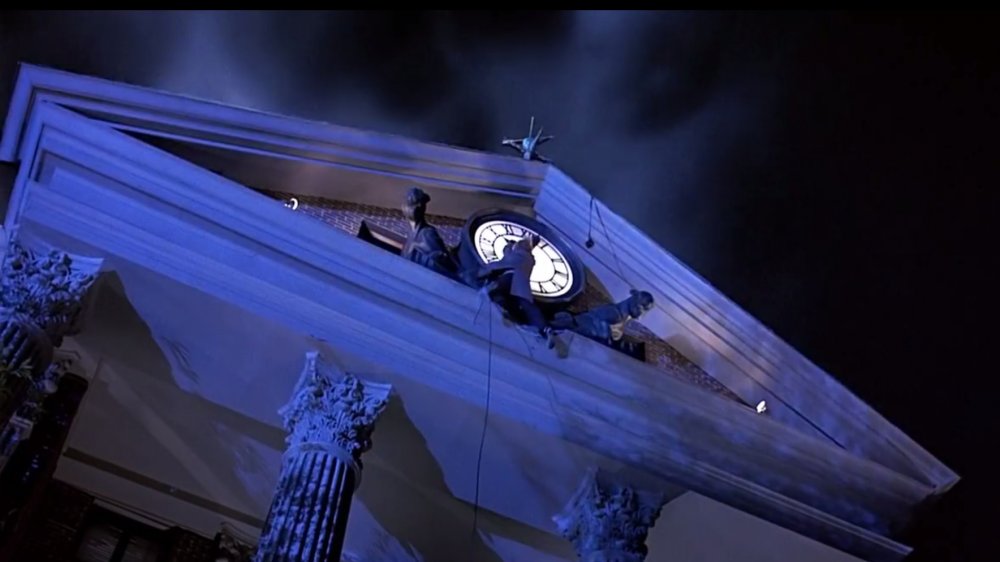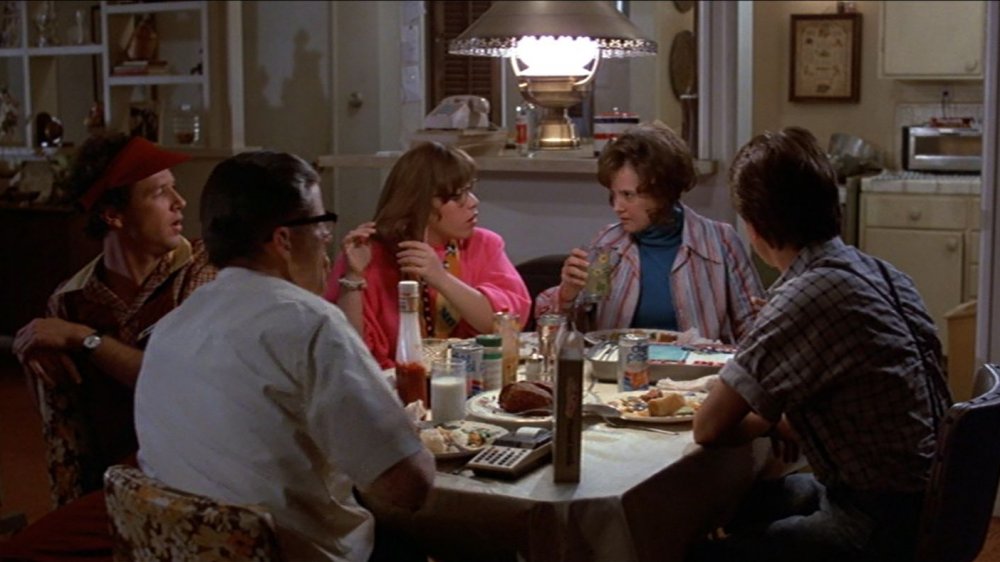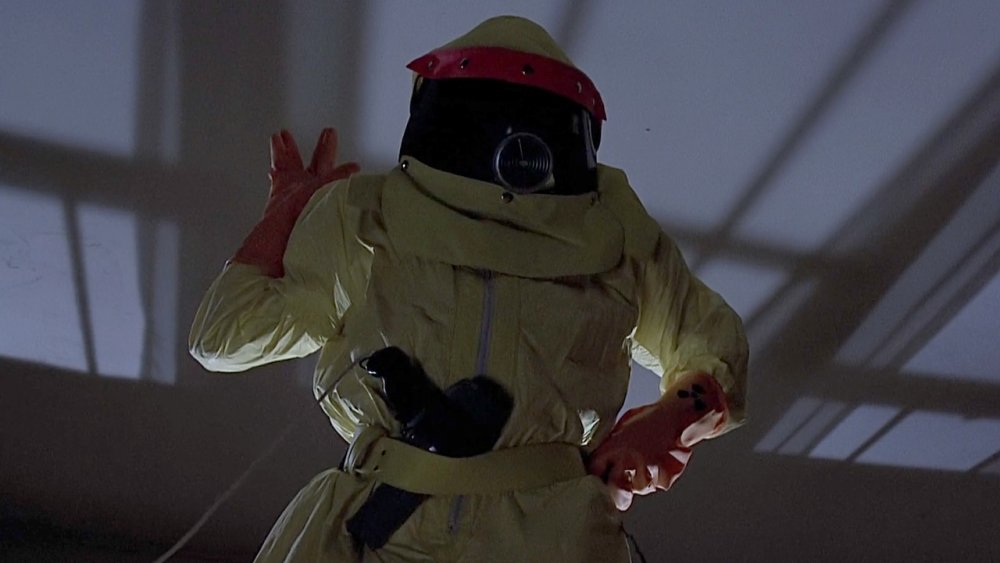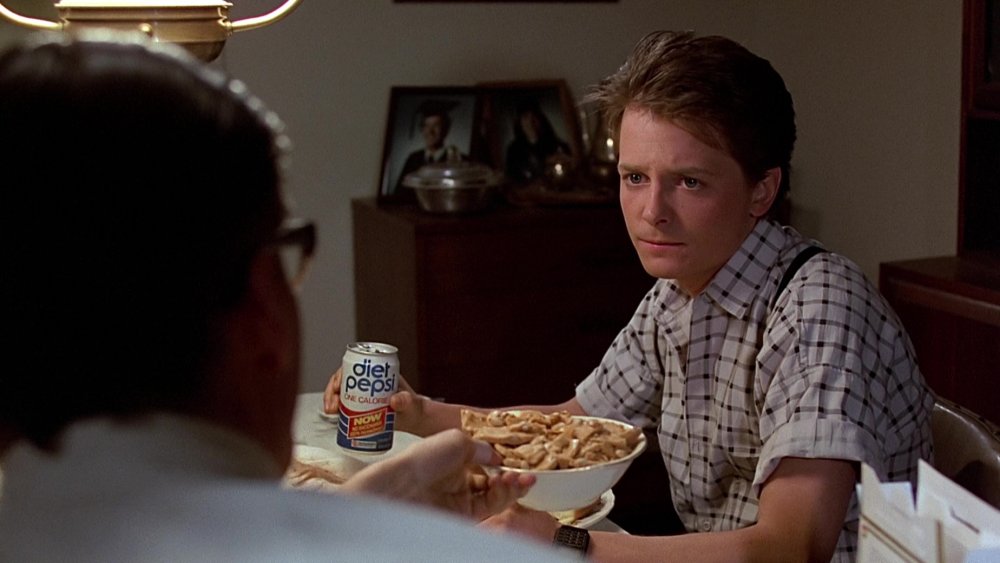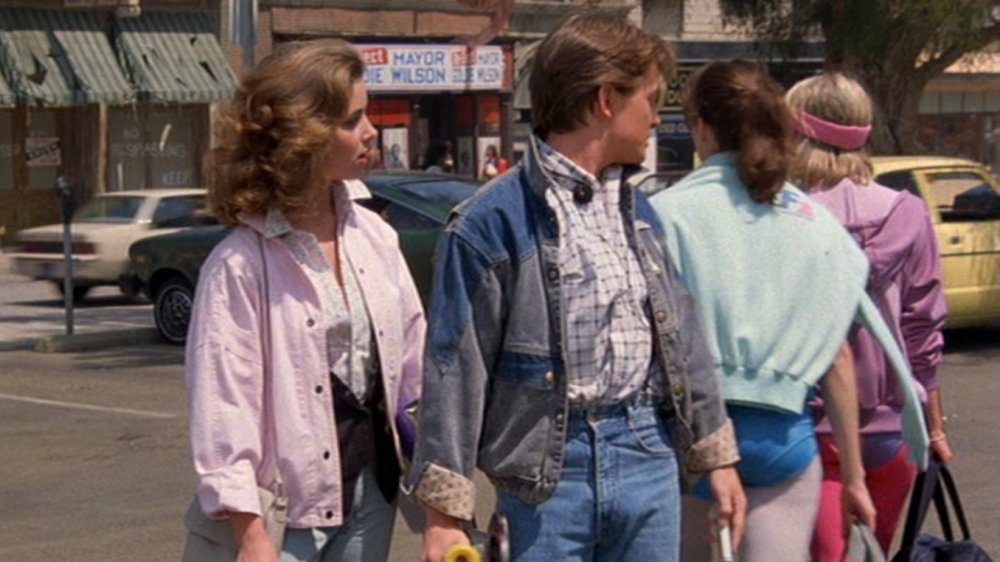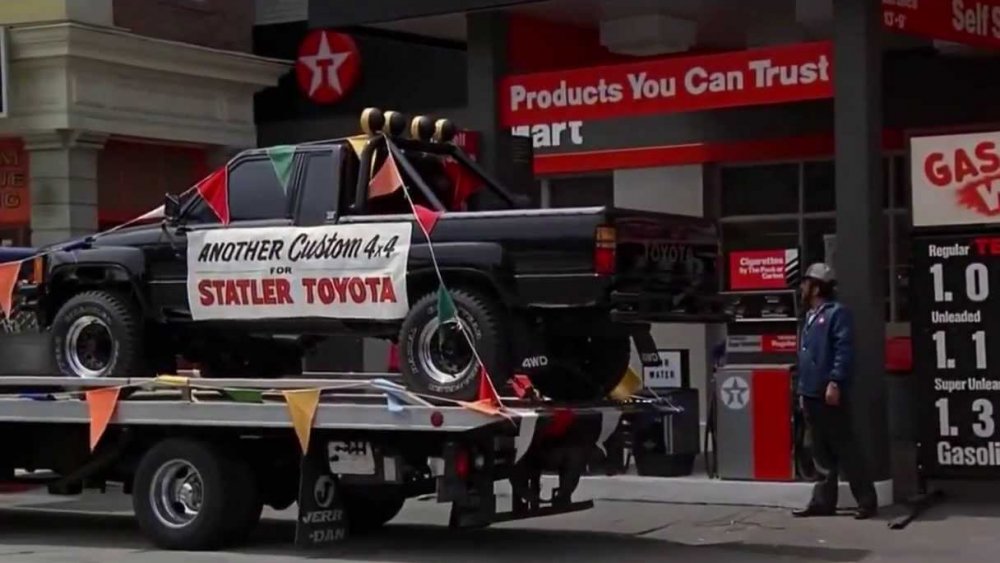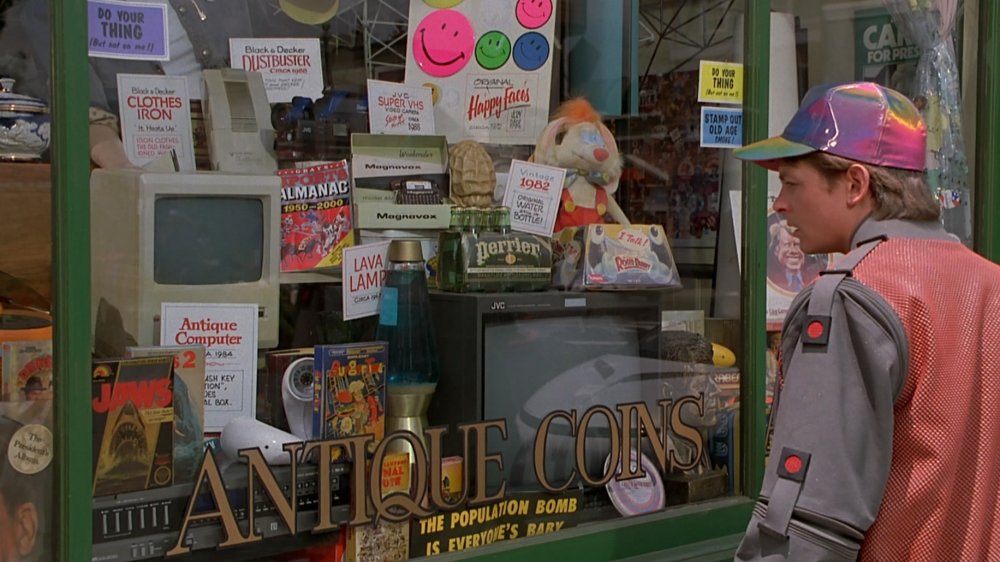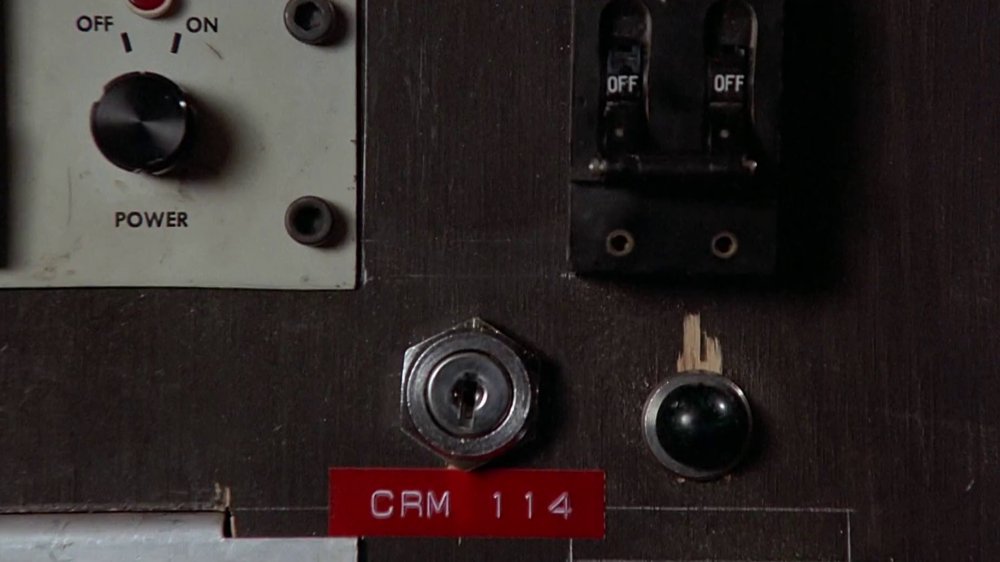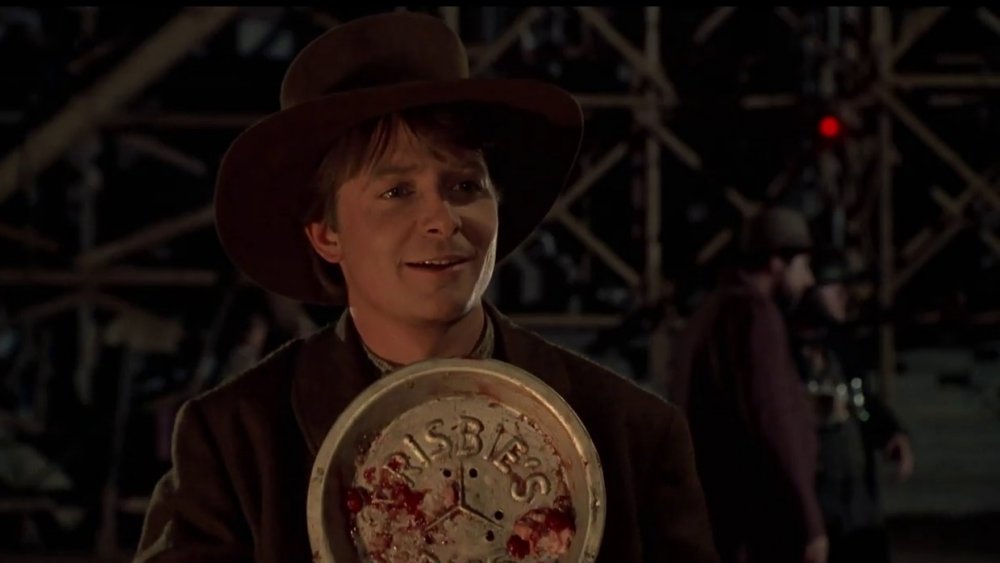Small Details In The Back To The Future Movies You Missed
This content was paid for by Netflix and created by Looper.
There's a lot to love about the Back to the Future trilogy. There's the bromance between wannabe rock star Marty McFly (Michael J. Fox) and eccentric scientist/inventor Emmett "Doc" Brown (Christopher Lloyd). There's the thrill of watching Marty try to navigate life in 1955 and seeing his parents as teens. There's the weird science that makes no sense but sounds like fun. And there are the two sequels that tinker with the original just enough to keep you along for the ride.
As well as all that obviously awesome stuff, there are some subtle details the filmmakers worked carefully into these movies. The props, costumes and sets all feature their own clues about the characters, the plot and real-life films. With all that in mind, here's a look at some of the many small details in the Back to the Future movies that you might have missed the first time around.
The first scene revealed a major plot detail in a very subtle way
The Back to the Future set designers started dropping plot hints within the first minute of the film. The opening scene in Doc's lab/home shows dozens of synchronized ticking clocks. This is a tribute to the classic 1960 time travel movie The Time Machine, in which eccentric inventor H. George Wells (Rod Taylor) has a similar collection of aligned timepieces.
Doc's collection looks pretty random, but one of the clocks gives away a major scene from the end. At about a minute in, we see a miniature model of a clock tower with a man holding onto the minute hand. Like all but one of Doc's clocks, the time on this one is 25 minutes slow. (The clock with the correct time can be seen right before Marty pushes his skateboard into the box of plutonium: it's lying on its side on the floor and showing 8:18.) Later in the movie, in 1955, Doc Brown dangles off the minute hand of the Hill Valley clock tower as he tries to connect the cable to channel the lightning bolt.
However, this prop wasn't made for Back to the Future. It was a real clock made in tribute to a different movie: the 1923 silent film Safety Last! in which actor Harold Lloyd also clung to the minute hand of a clock above a busy street. Actors named Lloyd can't seem to avoid clock towers.
Doc Brown's decorative choices hint at his character's backstory
Doc Brown's decor gives away details about his personality and backstory. He's framed and hung two newspaper articles with the headlines "Brown Estate Sold To Developers: Bankrupt Inventor Sells off 435 Prime Acres" and "Brown Mansion Destroyed." That last one includes a picture of firefighters looking at the smoldering remains of a house, meaning the mansion probably burned down. It overlaps the other, which implies that it's a more recent story.
So now we know that Doc was once wealthy but went bankrupt, and that his house was destroyed in a fire. When Marty meets Doc in 1955, he's still living in the mansion. This explains a small detail that at first looks like an inconsistency. Doc's house number in 1985 is 1646, but in the 1955 phone book he's listed at 1640 Riverside Drive. When the mansion burned down, Doc moved into the garage of the property.
Another decorative note: in 1985, Doc has framed photos of three notable scientists and inventors: Benjamin Franklin, Thomas Edison, and Albert Einstein. In 1955, these framed photos are seen on his fireplace, along with one of Isaac Newton. Did Doc dump Newton — and his flying car-defying theory of gravity — over the next 30 years?
Biff Tannen was named in revenge
In their feature commentary on the 2005 Back to the Future DVD trilogy set, writer Bob Gale and writer/director Robert Zemeckis revealed where they got the inspiration for some of the main characters' names. Marty's name was chosen simply because it was easy to say, but that they sometimes named characters after people they knew. Specifically, eternal villain Biff Tannen and the rest of his no-good family were named after Ned Tanen, who was president of Universal from 1976 to 1982.
Tanen is something of a legend among movie lovers: he led Universal's charge in bringing youth-oriented movies like Jaws, E.T., Animal House, and American Graffiti to the screen, and later produced Sixteen Candles, The Breakfast Club, and St. Elmo's Fire. But Gale and Zemeckis had another perspective. When they were working on their 1978 Beatlemania comedy I Wanna Hold Your Hand, Tanen threw their script on the floor and accused them of making an anti-Semitic movie, even though both Gale and Zemeckis are Jewish. They couldn't have known how successful and long-lasting their small act of revenge would be.
Pay attention to the fashion
In Back to the Future, Marty wears a button on his oh-so-'80s multi-shade denim jacket that has a weird history in real life. This button would have been considered retro in 1985 — and possibly political. It's from an exhibition called Art in Revolution: Soviet Art and Design After 1917 that showed in London's Hayward Gallery from February 26 to April 18, 1971. The exhibition was created in collaboration with the Soviet Ministry of Culture, who forced the gallery to seal off one of the rooms they'd been intending to show because they deemed the art "too decadent." The graphics, like the red, white and black one featured on Marty's button, were designed by Michael Brawne and Edward Wrigh. Exactly how Marty came across this button may be one of the dumb things in Back to the Future everyone ignored — or maybe it fits in perfectly with his rebellious attitude.
There are clever fashion moments in the trilogy. That denim jacket ends up in an antiques store in 2015: Gale described this as an "inside joke" for the audience, rather than a plot device. But one of Doc's shirts is plot-related. In Back to the Future Part II he wears a yellow shirt printed with trains followed by two horses, foreshadowing a pivotal scene in the following movie. The shirt returned for the third film: Gale confirmed that Doc wears it when he and Marty hold up the train, making it even more meta.
Two famous musicians had cameos in Back to the Future
Before his very existence was threatened, Marty's main concern was that his band the Pinheads failed their audition for Battle of the Bands. Barely 20 seconds into their shredding rendition of "The Power of Love" by '80s rockers Huey Lewis and the News, a staid school administrator tells them "I'm afraid you're just too darn loud."
That staid school administrator was actually played by Huey Lewis, who wrote and performed the very song his character interrupts. Lewis was reluctantly persuaded to write "The Power of Love" for the movie, as well as "Back in Time," and the former earned the band Oscar and Grammy nominations. It took even more persuasion to get Lewis to appear in the film: he only agreed to do it if he could be in disguise and uncredited.
Another rock star who couldn't quite resist the pull of Back to the Future was guitar legend Eddie Van Halen. After nearly three decades of speculation, Eddie admitted that he did indeed supply the music Marty uses to lightly torture his teenage father into asking out his mother in 1955. The tape Marty inserts into the cassette player reads "Edward Van Halen." In 2012, Eddie admitted to TMZ that it was him playing, but didn't exactly call it music: he said he was "just playing a bunch of noise."
Look out for these subtle cameos in Back to the Future Parts II and III
The Back to the Future sequels also landed famous cameos. Flea, the bassist of the Red Hot Chili Peppers, played Needles, Marty's road race challenger in 1985 and corrupt colleague in 2015. The band was on tour at the time, which made for a challenging shoot schedule. Flea told Rolling Stone that he only got two hours sleep the night before shooting all of his scenes in one go, recalling, "It's just a blur... I think I only saw those movies when they came out. Never since."
The group that appeared in Back to the Future Part III was more enthusiastic. Rock band ZZ Top wrote the song "Doubleback" for the 1990 trilogy finisher, and you can see them performing an acoustic version in the 1885 Hill Valley Festival, dressed in Wild West gear. The group was so convincing in their costumes — thanks in part to their famous beards — that they were mistaken for extras.
The Wild West theme gave the filmmakers the chance to sneak in some other cameos as a subtle nod to the genre. In the saloon, the three cowboys are actually three veteran Western actors. Dub Taylor played Cannonball, a sidekick in the Wild Bill Elliott Westerns. Harry Carey Jr. appeared in seven John Ford Westerns. And Pat Buttram not only appeared in Western films, he started the Golden Boot Awards to honor people in the industry.
The continuity department nailed these small changes
When you're making a time travel movie, you have to keep track of changes characters make to the past and carry them (ahem) back to the future. Otherwise fans will notice and hold you accountable for the rest of your career (which is why a decades-long Back to the Future plot hole has finally been explained.)
The Back to the Future team pulled this off brilliantly — and you probably didn't even notice. When Marty and Doc meet up in 1985, they rendezvous at Twin Pines Mall. We get to see the namesakes of the mall in 1955: Peabody's ranch has two pine trees standing next to each other, and Marty accidentally knocks one over as he drives the DeLorean away from the farmer's irate family. When we go back to 1985, after all his time tampering, it's now called Lone Pine Mall.
Another detail the filmmakers got right relates to the clock tower. When Doc is trying to connect the cables, he accidentally breaks off a chunk of the tower. In the original 1985, the tower is intact (apart from the nonfunctional clock.) But when Marty returns to 1985, we can see the damaged façade. Considering he spent a week in the past, it's remarkable these are the only things he managed to change outside of his family's fortunes (although the dedicated members of the Save the Clock Tower Fund might not be too happy.)
Multiple generations of Marty's family love meatloaf and sci-fi
The Back to the Future trilogy taught us that certain personality traits run in families. In the Tannen family's case, it's being evil and getting covered in manure. In Marty's family's case, it's watching sci-fi shows and eating meatloaf for dinner.
At the beginning of the first film, fully grown George McFly (Crispin Glover) and his oldest son Dave (Marc McClure) laugh dorkily at The Honeymooners, a sitcom about a married couple that aired a total of 39 episodes between 1955 and '56. The episode they're watching is "The Man from Space," foreshadowing George's close encounter with 'Darth Vader from the planet Vulcan' in 1955. It's the same one teenage Lorraine's family is watching over dinner back in 1955, which they tell Marty is brand new. But the episode aired on December 31, 1955, not November 5 of that year, the date Marty went back to. The other similarity in the family scene is the dinner they're eating: 30 years apart, both generations of Lorraine's family are tucking into meatloaf, but they finally switch to pizza in 2015.
Steven Spielberg saved the film from a very weird name
If you haven't seen the film, the title Back to the Future sounds impossible: how do you go back to something that happens later? Universal CEO Sid Sheinberg had the same question in 1984, when, instead of rereading the script, he sent a memo to executive producer Steven Spielberg with an alternative suggestion to the "less than 'wonderful'" title.
Sheinberg wanted to call the film Space Man from Pluto, which he felt had "heat, originality and projects fun." They would work the title into the script: for example, Marty would tell George that he was a "space man from the Planet Pluto" instead of Darth Vader from the planet Vulcan.
Spielberg took a tactful approach to resolving the situation. Rather than outright refuse and risk an argument with an executive, he thanked Sheinberg for giving everyone a laugh with his hilarious memo. As Spielberg had predicted, Sheinberg was too embarrassed to admit that he'd been serious, and the original title stuck. But the Peabody kid's comic does promise "Space zombies from Pluto."
Sheinberg did get to change a different name, though. According to the DVD commentary with Gale and Zemeckis, Marty's mom was originally called Meg, but Sheinberg told them to change it to Lorraine — the name of his wife, Lorraine Gary, who you may also know Gary as Police Chief Brody's wife Ellen in Jaws.
Marty really like Pepsi and Pepsi really liked being on screen
If you find yourself craving Pepsi when the end credits of Back to the Future roll, blame product placement. Pepsi drinks appear throughout the films: the company received screentime in exchange for providing the cast and crew free Pepsi. Cans and bottles can be seen in Marty's bedroom, on the McFly and Baines family dinner tables, and in the antiques store window in 2015. Marty tries to order a Pepsi Free from Lou's diner in 1955, and gets a Pepsi Perfect from the '80s diner in 2015. Pepsi actually introduced a version of this fictional product to mark October 21, 2015, a date Marty traveled to.
Pepsi wasn't the only company getting exposure. Gale and Zemeckis wanted to show lots of real brands to make the films feel authentic: look out for Miller beer trucks in 1985 and 1955, Kellogg's cereal, Marty's Nikes and his Calvin Klein underwear, the Burger King next door to Doc's in 1985 (and the Whopper wrapper in his garage) and the Toyota 4X4 Marty lusts after.
One of the least subtle placements is the Pizza Hut half pepperoni/half green pepper hydratable pizza, prepared in a Black & Decker Hydrator in Back to the Future Part II. The Hut took the partnership off screen too, selling promotional sunglasses tied to the movie for the bargain price of $1.99 with the purchase of any pizza. (If you missed out, you can still find them on eBay.)
The crew snuck shoutouts into the background
The poster for the Enchantment Under the Sea Dance is a crucial plot point — Doc and Marty realize it's the perfect place to get Marty's parents together. But take a second look at the walls of Hill Valley High School in 1955 and you'll also see a poster advertising "Ron Woodward for Senior Class President: The right man for the job." Ronald Woodward was Back to the Future's key lighting grip.
Other subtle crew shout-outs appear on certain cars. As Marty and Jennifer (Claudia Wells) walk through the town square in 1985, they pass a car with a blue license plate that says "FOR MARY." Mary T. Radford was the personal assistant to Frank Marshall, an executive producer and the second unit director. And in 1955, the man pictured on the campaign poster to re-elect Mayor "Red" Thomas is set decorator Hal Gausman.
This detail contradicts a fan theory. When Marty gets back to 1985, he startles a homeless man played by George "Buck" Flower, whom he greets as Red. Some viewers thought this implied that Red Thomas had gone from mayor to sleeping rough. However, according to Bob Gale in his DVD commentary, Fox improvised this name and the characters aren't connected. But the film name on the theater marquee in 1985, Orgy American Style, is the name of a film Flower appeared in in 1973 — and just one of the Back to the Future details that only adults notice.
This is one of the Back to the Future creators' favorite details
The Back to the Future trilogy tells the story of multiple generations of the same families: the McFlys, the Tannens and... the Statlers? You might not be able to place the name, but the Statler family has been a fixture of the movies since the start of the first film — and since 1885.
In an FAQ answering some of the most commonly asked Back to the Future questions, Zemeckis and Gale wrote that people should look for references to the Statlers' various transportation businesses. The first dialogue in the trilogy is an ad played over a clock radio for the Statler Toyota dealership in downtown Hill Valley: the one selling the 4X4 Marty eventually gets. In 1885, Honest Joe Statler buys and sells horses, and in 1955, the family has a Studebaker dealership in the town square (they have a billboard at the drive-in theater in Back to the Future Part III.)
There's one more family that's had an impact on Hill Valley throughout the decades. Former diner employee-turned mayor Goldie Wilson (Donald Fullilove) passed his political aspirations to the next generation: a campaign poster in 2015 reads "Re-elect Mayor Wilson Jr." Meanwhile, the third Wilson generation took a different career path: Fullilove plays Goldie Wilson III in a hologram ad for a service that turns your boring old road car into one that flies.
Look out for these tributes to other films
Once you've rewatched the Back to the Future trilogy a hundred times, you can find your next movie recommendation in... the Back to the Future trilogy. But you'll have to look closely. There are titles and references to projects various members of the cast and crew worked on hidden throughout.
For example, when Marty hitches a ride to school on the back of a Jeep in the first movie, he skates past a sign that reads "Used Cars," the title of a 1980 movie by Gale and Zemeckis. (By the way, the driver of the Jeep is not Steven Spielberg or Harrison Ford: Gale and Zemeckis confirmed in the DVD commentary that it's the film's stunt coordinator, Walter Scott.)
The second movie has even more references. Look for the Roger Rabbit toy in the antiques store window. Zemeckis directed Who Framed Roger Rabbit in 1988 — the year before Back to the Future Part II came out — which also starred Christopher Lloyd. Also in the window are Jaws and Jaws 2 VHS tapes: executive producer Steven Spielberg directed the first movie to great acclaim in 1975. The subsequent three sequels were less successful, including 1987's Jaws: The Revenge, which had the tagline "This time... It's personal." Back to the Future Part II plays off this: the tagline for Jaws 19 is "This Time It's REALLY REALLY Personal." According to the marquee, the movie is directed by Max Spielberg, Steven's oldest son.
Marty's amp has a nod to a famous director
Doc's inventions belong to a long line of cool sci-fi machines, and Back to the Future pays a subtle tribute to one of them. When Marty is fiddling with the audio controls on the speaker at Doc's house, we briefly see a label that reads CRM 114. This is the name of a radio device from Stanley Kubrick's film Dr. Strangelove (and the book it was based on, Peter George's Red Alert.) CRM comes from real military electronic codes, so it actually doesn't make much sense on a huge speaker.
Back to the Future is one of many movies to pay onscreen homage to Kubrick's code. The director himself included the homonym Serum 114 in 1971's A Clockwork Orange. In Executive Decision, a device used to transmit messages on stealth planes is called CRM 115. In Jon S. Baird's 2013 adaptation of Irvine Welsh's novel Filth, the medicine jar and drugs inside are labeled Crm 115.
Another sci-fi movie gets an equally subtle tribute. The lights on the DeLorean's dashboard that display the dates are red, yellow and green, the same combination as the date lights on the time-traveling sled in the 1960 movie The Time Machine.
There are real history lessons hidden in jokes
In 1885, Marty invents the frisbee when he throws a metal pie dish from Frisbie's Pies at Mad Dog Tannen (Thomas F. Wilson). This might sound like a stretch: but this is actually pretty close to the origin story of frisbees — although on a different coast. Based in Bridgeport, Connecticut, the real life Frisbie Pie Company sold many of their pies to college students, who started tossing around the round, flat, empty tins for fun when they were finished eating. The first plastic version appeared in 1948, but the flying disc got the name Frisbee at toy company Wham-O in 1958.
There's another strange-but-real historical detail you probably missed in the first film. When Marty arrives in the town square in 1955, a kid walks — or rather bounces — past him on shoes with springs attached to the bottom. These were a real toy in the 1950s and '60s. Called Moon Shoes, satellite jumping shoes, or pogo shoes, they were supposed to make the wearer feel like they were walking on the moon — a tie-in to the space race that led to a fascination with all things intergalactic. However, since space fever really got going after 1957, when the Soviet Union launched Sputnik, the kid in Back to the Future may be ahead of his time. Just like Marty.
